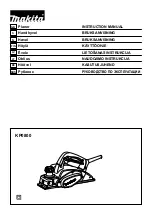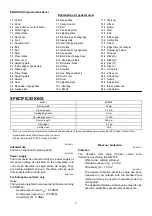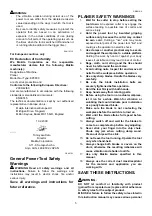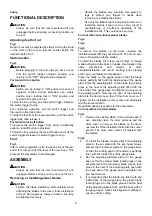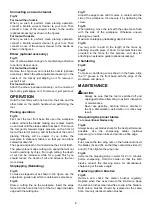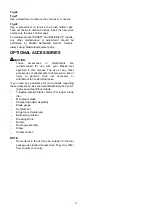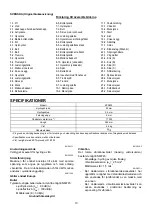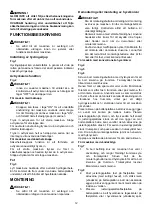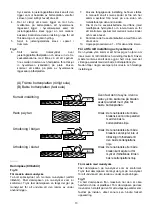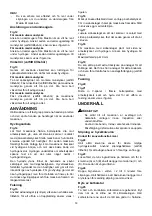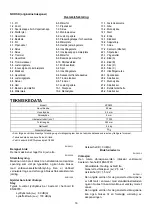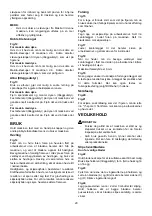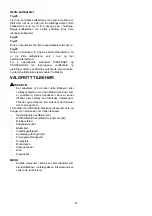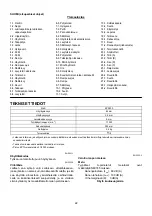
8
Connecting a vacuum cleaner
Fig.12
For tool without nozzle
When you wish to perform clean planing operation,
connect a Makita vacuum cleaner to your tool. Then
connect a hose of the vacuum cleaner to the nozzle
(optional accessory) as shown in the figures.
For tool with nozzle
When you wish to perform clean planing operation,
connect a Makita vacuum cleaner to your tool. Then
connect a hose of the vacuum cleaner to the nozzle as
shown in the figures.
Elbow (optional accessory)
Fig.13
Use of elbow allows change of chip discharge direction
to perform cleaner work.
For tool without nozzle
Remove the chip cover and install the nozzle (optional
accessory). Attach the elbow (optional accessory) on the
nozzle of the tool by just slipping on it. To remove it,
just pull it out.
For tool with nozzle
Attach the elbow (optional accessory) on the nozzle of
the tool by just slipping on it. To remove it, just pull it out.
OPERATION
Hold the tool firmly with one hand on the knob and the
other hand on the switch handle when performing the
tool.
Planing operation
Fig.14
First, rest the tool front base flat upon the workpiece
surface without the blades making any contact. Switch
on and wait until the blades attain full speed. Then move
the tool gently forward. Apply pressure on the front of
tool at the start of planing, and at the back at the end of
planing. Planing will be easier if you incline the
workpiece in stationary fashion, so that you can plane
somewhat downhill.
The speed and depth of cut determine the kind of finish.
The power planer keeps cutting at a speed that will not
result in jamming by chips. For rough cutting, the depth
of cut can be increased, while for a good finish you
should reduce the depth of cut and advance the tool
more slowly.
Shiplapping (Rabbeting)
Fig.15
To make a stepped cut as shown in the figure, use the
edge fence (guide rule) which is obtained as accessory.
Fig.16
Draw a cutting line on the workpiece. Insert the edge
fence into the hole in the front of the tool. Align the blade
edge with the cutting line.
Fig.17
Adjust the edge fence until it comes in contact with the
side of the workpiece, then secure it by tightening the
screw.
Fig.18
When planing, move the tool with the edge fence flush
with the side of the workpiece. Otherwise uneven
planing may result.
Maximum shiplapping (rabbeting) depth is 9 mm.
Fig.19
You may wish to add to the length of the fence by
attaching an extra piece of wood. Convenient holes are
provided in the fence for this purpose, and also for
attaching an extension guide (optional accessory).
Chamfering
Fig.20
Fig.21
To make a chamfering cut as shown in the figure, align
the "V" groove in the front base with the edge of the
workpiece and plane it.
MAINTENANCE
CAUTION:
•
Always be sure that the tool is switched off and
unplugged before attempting to perform inspection
or maintenance.
•
Never use gasoline, benzine, thinner, alcohol or
the like. Discoloration, deformation or cracks may
result.
Sharpening the planer blades
For conventional blades only
Fig.22
Always keep your blades sharp for the best performance
possible. Use the sharpening holder (optional
accessory) to remove nicks and produce a fine edge.
Fig.23
First, loosen the two wing nuts on the holder and insert
the blades (A) and (B), so that they contact the sides (C)
and (D). Then tighten the wing nuts.
Fig.24
Immerse the dressing stone in water for 2 or 3 minutes
before sharpening. Hold the holder so that the both
blades contact the dressing stone for simultaneous
sharpening at the same angle.
Replacing carbon brushes
Fig.25
Remove and check the carbon brushes regularly.
Replace when they wear down to the limit mark. Keep
the carbon brushes clean and free to slip in the holders.
Both carbon brushes should be replaced at the same
time. Use only identical carbon brushes.
Summary of Contents for KP0800J
Page 53: ...53 ...
Page 54: ...54 ...
Page 55: ...55 ...
Page 56: ...56 Makita Corporation Anjo Aichi Japan www makita com 884915C982 ...

